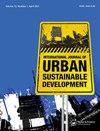用人工社会方法模拟城市外围地区分散居住的再集中
IF 2.4
Q3 ENVIRONMENTAL STUDIES
International Journal of Urban Sustainable Development
Pub Date : 2023-01-02
DOI:10.1080/19463138.2022.2157005
引用次数: 0
摘要
本文章由计算机程序翻译,如有差异,请以英文原文为准。
Simulating the re-concentration of dispersed habitation in the peripheral urban area using an artificial society approach
ABSTRACT This study proposes an exploratory urban morphology agent-based model (ABM) to simulate the combined impact of the establishment of hub facilities that urban residents can conveniently access, policies for promoting human interactions around them, and the introduction of trams amidst dispersed habitations in peripheral urban areas. The proposed model offers a new perspective on ways to improve the urban environment. It describes a shift from dispersed habitation to concentrated habitation in a bottom-up manner through behavioural changes at the micro level, which lead to productive human interactions in an urban setting. Specifically, the model experimentally demonstrates a trade-off between increased human interactions caused by the introduction of hub facilities that attract a diverse range of activities, and policies that promote such interactions and development amongst dispersed habitation. Additionally, the model suggests that the direction of urban growth is a consequence of collective action, implying that collaborative efforts can facilitate its improvement.
求助全文
通过发布文献求助,成功后即可免费获取论文全文。
去求助
来源期刊

International Journal of Urban Sustainable Development
ENVIRONMENTAL STUDIES-
CiteScore
4.00
自引率
4.00%
发文量
24
期刊介绍:
International Journal of Urban Sustainable Development aims to provide a forum for cutting-edge research and rigorous debate for an in-depth and holistic understanding of the complex inter-related environmental, social, economic, political, spatial, institutional and physical challenges facing urban areas. Its premise is that multi-disciplinary approaches provide the space for the range of disciplines and perspectives related to the full breadth of issues that affect urban sustainable development.
 求助内容:
求助内容: 应助结果提醒方式:
应助结果提醒方式:


